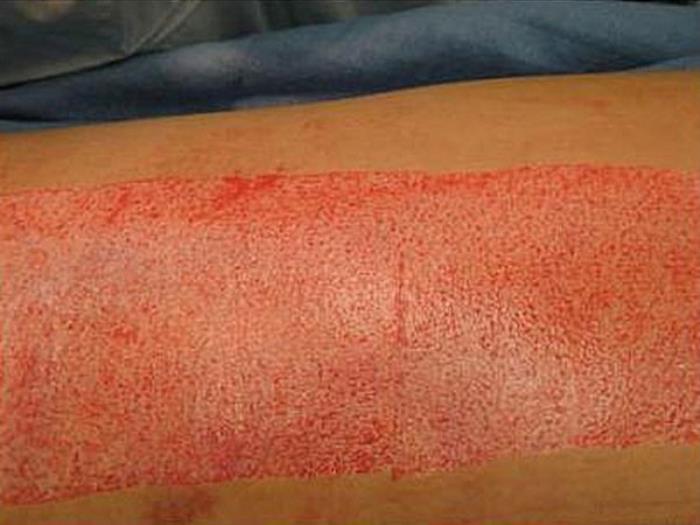Pediatric burn treatment is a specialized area of medicine focused on addressing the unique needs of children who suffer from burn injuries. Burns in children can be particularly devastating due to their potential impact on physical health, development, and emotional well-being.
Effective treatment often involves a multidisciplinary approach, including wound care, pain management, and surgical interventions such as skin grafting. Understanding the intricacies of pediatric burn treatment is crucial for providing optimal care and improving long-term outcomes for young patients.
Unique Challenges of Skin Grafting in Pediatric Patients
Skin grafting in pediatric patients presents unique challenges due to the anatomical and physiological differences between children and adults. Children have thinner skin, which can make the grafting process more delicate and increase the risk of complications.
Additionally, pediatric patients may have less body surface area available for donor sites, limiting the options for harvesting skin. Emotional and psychological factors also play a significant role, as children may have difficulty understanding the procedure, leading to anxiety or fear.
The Importance of Skin Grafting in Treating Pediatric Burns
Skin grafting is vital in treating pediatric burns, particularly for severe or deep second-degree and third-degree burns. It serves to restore the integrity of the skin, promote healing, and reduce complications such as infection and scarring.

By covering large burn wounds with healthy skin, grafting accelerates the healing process and improves functional and aesthetic outcomes, which is crucial for a child's development and self-esteem.
In many cases, skin grafting is necessary to ensure that children regain normal skin function and appearance, ultimately enhancing their quality of life after a burn injury.
Types of Burns Commonly Seen in Children
Children are susceptible to various types of burns, each requiring specific treatment approaches. Common types include:
- Thermal burns: often caused by hot liquids, flames, or contact with hot surfaces.
- Chemical burns: resulting from exposure to corrosive substances.
- Electrical burns: from contact with electrical currents.
- Radiation burns: from sun exposure or medical treatments.
Each type of burn presents different risks and requires tailored treatment strategies to ensure effective healing and minimize long-term complications.
Factors Influencing Skin Grafting Decisions in Pediatric Patients
Several factors influence the decision to perform skin grafting in pediatric patients, including the severity and depth of the burn, the child's overall health, and the potential for functional impairment.

Surgeons consider the age of the child, as younger patients may have different healing capacities and growth considerations. The location of the burn is also critical, as areas with high movement, such as joints, may require more complex grafting techniques to ensure proper healing and function.
Ultimately, the decision to proceed with skin grafting is made collaboratively among the medical team, the child, and their caregivers, focusing on achieving the best possible outcomes for the young patient.
Assessing Burn Severity: The Role of the Pediatric Burn Team
The pediatric burn team plays a crucial role in assessing burn severity, which is essential for determining appropriate treatment. This multidisciplinary team, including pediatric surgeons, nurses, nutritionists, and physical therapists, evaluates the extent and depth of burns to establish a comprehensive treatment plan tailored to the child’s needs.
Pediatric Skin Graft Donor Sites: Considerations and Selection
When selecting donor sites for skin grafts in children, factors such as skin quality, color match, and the potential impact on growth and development are considered. Donor sites should ideally be chosen from areas that are less visible and can heal effectively, minimizing scarring and functional impairment.

Healing Differences: Pediatric Skin vs. Adult Skin
Pediatric skin is more resilient and has a higher regeneration capacity than adult skin. Children tend to heal faster due to the increased cellular turnover and elasticity of their skin. However, they are also more susceptible to complications such as infection, making careful monitoring essential during the healing process.
Special Anesthesia Considerations for Pediatric Burn Surgery
Anesthesia for pediatric burn surgery requires careful consideration of the child’s age, weight, and medical history. Pediatric anesthesiologists utilize age-appropriate techniques and medications to ensure safety and comfort, taking into account the unique physiological characteristics of children.

The Role of Family Support in Pediatric Burn Treatment
Family support is vital in the recovery of pediatric burn patients. Involvement of parents and caregivers during treatment and rehabilitation helps children feel secure and reduces anxiety. Family education about the healing process and active participation in care can significantly enhance recovery outcomes.
Managing Pain and Anxiety in Young Patients Post-Grafting
Effective pain management is critical for young patients post-grafting. Strategies may include a combination of medication, distraction techniques, and psychological support to alleviate anxiety. Creating a calm environment and providing reassurance can help children cope with discomfort and fear during recovery.
Nutritional Needs During Recovery from Burn Surgery
Nutrition plays a key role in the recovery of pediatric burn patients. Increased caloric intake, particularly from protein sources, is essential to support healing and muscle preservation. A nutritionist can help develop a tailored dietary plan to meet the specific needs of the child during recovery.
Rehabilitation and Physical Therapy for Pediatric Burn Survivors
Rehabilitation and physical therapy are crucial for restoring function and mobility in pediatric burn survivors. Early intervention helps prevent contractures and promotes optimal healing. Therapists work with children to improve strength, flexibility, and coordination, facilitating a return to normal activities.
Long-Term Monitoring of Skin Graft Outcomes in Children
Long-term monitoring of skin graft outcomes in pediatric patients is important to assess healing and detect any complications early. Regular follow-ups with the burn team can help ensure that the grafts integrate properly and that the child’s overall skin health is maintained.
Psychological Support for Pediatric Burn Patients and Families
Psychological support is vital for pediatric burn patients and their families. Children may experience anxiety, depression, or body image issues following a burn injury. Access to counselors and support groups can help families cope with the emotional impact of burn treatment and recovery.
Strategies for Minimizing Scarring and Promoting Healing
To minimize scarring, strategies may include the use of silicone gel sheets, compression garments, and appropriate wound care practices. Early intervention and adherence to follow-up care can significantly reduce the likelihood of hypertrophic scars and improve cosmetic outcomes.
Educating Parents: What to Expect During the Healing Process
Education for parents is essential in preparing them for the healing process after a child's burn surgery. Parents should be informed about the stages of healing, signs of complications, and strategies for care at home, ensuring they feel equipped to support their child through recovery.
Community Resources for Pediatric Burn Care and Recovery
Various community resources are available to support pediatric burn care and recovery, including local burn centers, support groups, and organizations that offer educational materials and financial assistance. Connecting families with these resources can enhance support and facilitate healing.
Advances in Pediatric Burn Treatment and Skin Grafting
Recent advancements in pediatric burn treatment and skin grafting include improved wound care technologies, bioengineered skin substitutes, and innovative surgical techniques. These advancements aim to enhance healing, reduce complications, and improve the overall quality of care for pediatric burn patients.
Conclusion: Prioritizing Pediatric Needs in Skin Grafting for Burns
Prioritizing the unique needs of pediatric patients in skin grafting for burns is essential for achieving optimal outcomes. A collaborative approach involving a multidisciplinary team, family support, and access to resources ensures that children receive the best possible care during their recovery.
The Importance of Skin Graft Donor Sites in Burn Treatment
Understand the critical role of donor sites in the skin grafting process. This section discusses how the selection and management of donor sites can affect the healing of both the grafted area and the donor site itself, emphasizing the need for careful planning and care in burn treatment.
The Role of Compression Therapy After Skin Grafting
Discover the benefits of compression therapy following skin grafting. This section explains how compression can help improve healing, minimize scarring, and support the newly grafted skin, making it an essential component of post-operative care.
Best Skin Grafts for Burn Treatment in India
The Best Skin Grafts for Burn Treatment in India offer effective solutions for severe burns, helping restore skin function and appearance through advanced surgical techniques.
Best Hospitals for Skin Grafts in India
The Best Hospitals for Skin Grafts in India are equipped with cutting-edge technology and experienced specialists, providing comprehensive care for patients from initial consultation to recovery.
Skin Graft Surgery Cost in India
The Skin Graft Surgery Cost in India is affordable and transparent, ensuring patients receive high-quality care without compromising on the standards of treatment.
Best Skin Graft Surgeons in India
The Best Skin Graft Surgeons in India are experts in reconstructive surgery, providing personalized and precise care to ensure the best outcomes for burn patients.
FAQ
What are the most common types of burns in children requiring skin grafting?
The most common types of burns in children requiring skin grafting include scald burns from hot liquids, flame burns from fire, and contact burns from hot surfaces or objects. These injuries can vary in severity, necessitating skin grafting for deeper burns.
How does the healing process differ for pediatric skin grafts compared to adults?
Pediatric skin grafts typically heal faster than adult grafts due to the enhanced regenerative capabilities of children's skin. However, children are also more prone to complications, such as infection, requiring close monitoring.
What special considerations are there for anesthesia in pediatric burn surgeries?
Anesthesia for pediatric burn surgeries requires careful consideration of the child's age, size, and overall health. Pediatric anesthesiologists often use age-appropriate drugs and techniques to ensure safety and comfort.
How can parents support their child during recovery from skin grafting?
Parents can support their child during recovery by being actively involved in their care, providing emotional support, and ensuring adherence to post-operative instructions. Encouraging open communication can also help address any fears or concerns.
Are there any long-term effects of skin grafting on a child’s growth and development?
While skin grafting typically does not impact a child’s overall growth and development, it may lead to cosmetic changes or functional limitations in the grafted area. Ongoing monitoring and rehabilitation can help mitigate any potential issues.
Related Resources
At ArogyaJivan, we strive to provide you with the most accurate and up-to-date information to help you make informed decisions about your healthcare. Whether you are searching for the Best Doctors in India or the Top 5 Doctors in India, our resources are tailored to guide you through your medical journey. Additionally, our comprehensive guides on the Best Hospitals in India and the Top 5 Hospitals in India will assist you in choosing the right healthcare facility for your needs. Explore these resources to ensure you receive the best possible care.
